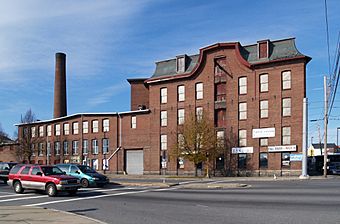Davol Mills facts for kids
Quick facts for kids |
|
|
Davol Mills
|
|
|
U.S. Historic district
Contributing property |
|

Mill No. 1
|
|
| Location | Fall River, Massachusetts |
|---|---|
| Built | 1867, 1871 |
| Architectural style | Second Empire |
| Part of | Corky Row Historic District (ID83000656) |
| Added to NRHP | June 23, 1983 |
The Davol Mills is a really old and important factory building in Fall River, Massachusetts. It was built a long time ago, in 1867, and then made bigger in 1871. This special building is known for its unique red brick style, called Second Empire. Because it's so important to history, it was added to the National Register of Historic Places in 1983. It's part of a bigger historic area called the Corky Row Historic District.
History of Davol Mills
Starting the Company
The Davol Mills Company began in 1866. Nineteen people worked together to start it. They gathered $270,000 to get the company going. The company was named after William C. Davol. He was a machinery builder. He brought a special machine called the Roberts Self-acting Mule to Fall River in the 1840s. This machine helped make cloth.
Building the Mills
The first factory building, called Mill No. 1, was built in 1867. It was located at the corner of Rodman Street and Plymouth Avenue. The machines inside were ready to work by March 1868. At first, Davol Mills made different kinds of cotton fabrics. These included shirtings, sheetings, and fancy fabrics.
In 1871, a second factory building, Mill No. 2, was built. It was connected to the first mill. By 1917, the Davol Mills had many machines. It had 44,000 spindles and 1,258 looms. These machines helped them make a lot of fabric.
Later Years and Closure
In 1924, the Davol Mills company bought another nearby factory. This factory was called the Tecumseh Mills. However, the Davol Mills eventually closed down. It shut its doors in 1935.
Years later, in 1968, the site was studied. It was part of a project called New England Textile Mills II. A photographer named Jack E. Boucher took pictures of the mills. These photos are now part of the Historic American Buildings Survey. This survey helps record important historic places.



